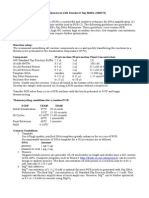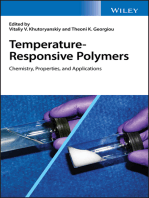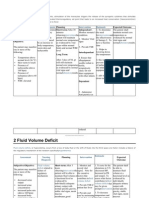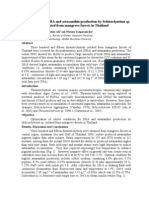Cloning Blunt-End DNA Fragments Into The Pgem - T Vector Systems
Cloning Blunt-End DNA Fragments Into The Pgem - T Vector Systems
Uploaded by
Khanh NhuCopyright:
Available Formats
Cloning Blunt-End DNA Fragments Into The Pgem - T Vector Systems
Cloning Blunt-End DNA Fragments Into The Pgem - T Vector Systems
Uploaded by
Khanh NhuOriginal Title
Copyright
Available Formats
Share this document
Did you find this document useful?
Is this content inappropriate?
Copyright:
Available Formats
Cloning Blunt-End DNA Fragments Into The Pgem - T Vector Systems
Cloning Blunt-End DNA Fragments Into The Pgem - T Vector Systems
Uploaded by
Khanh NhuCopyright:
Available Formats
Promega Notes Magazine Number 62, 1997, p.
15
Cloning Blunt-End DNA Fragments Into the pGEM-T Vector Systems
By Gary Kobs Promega Corporation Blunt-end DNA fragments can be ligated into Promega's T-Vectors if they are first "tailed" using dATP and Taq DNA Polymerase(a) (1). In this article, the results of two different A-tailing protocols were evaluated using a pGEM-T(b,c) Easy Vector System. A standard A-tailing protocol was compared to an abbreviated alternative protocol using both PCR products generated by thermostable DNA polymerases that have proofreading activity, and modified blunt-end DNA fragments generated by restriction digestion. The efficiency of cloning long PCR(d) fragments into the pGEM-T Vector Systems was also evaluated.
(a)Some
applications in which this product may be used are covered by patents issued and applicable in certain countries. Because purchase of this product does not include a license to perform any patented application, users of the product may be required to obtain a patent license depending upon the particular application and country in which the product is used. For more specific information, please contact Promega.
(b)Licensed (c)U.S.
under one or both of U.S. Pat. No. 5,487,993 and European Pat. No. 0 550 693.
Pat. No. 4,766,072 has been issued to Promega Corporation for transcription vectors having two different bacteriophage RNA polymerase promoter sequences separated by a series of unique restriction sites into which foreign DNA can be inserted.
(d)The
PCR process is covered by patents issued and applicable in certain countries. Promega does not encourage or support the unauthorized or unlicensed use of the PCR process.
Introduction
Certain thermostable polymerases, including Taq, Tfl and Tth DNA Polymerase(a) , add a single nucleotide, generally adenine, to the 3ends of amplified DNA fragments (2,3). Promega's T-Vector Systems (the pGEM-T, pGEM-T Easy and pTARGETTM(b) Vectors) are convenient systems for cloning PCR products generated by such thermostable polymerases. These linearized vectors contain single 3 terminal thymidines (T's) at each end which complement the A overhang added by the polymerase. Thus, PCR products can be directly subcloned into these vectors without further manipulation. Thermostable DNA polymerases that have a "proofreading" function, such as Pfu and Tli(a) DNA Polymerases, exhibit 3-->5 exonuclease activity (4,5) and produce greater than 95% blunt-end fragments. PCR fragments generated by proofreading enzymes can be ligated into the pGEM-T Vectors if they are first tailed with dATP using Taq DNA Polymerase (1). This A-tailing protocol can also be used to subclone DNA fragments generated by restriction enzymes which produce blunt ends (1).
Blunt-end PCR fragments
To determine how efficiently blunt-end PCR amplification products could be tailed, two fragments of 1,200bp and 500bp were amplified using both Pfu DNA polymerase and Tli DNA Polymerase. Both of these DNA polymerases generate blunt-end fragments. After amplification, the fragments were purified using the Wizard PCR Preps DNA Purification System (Cat.# A7170) (6). One to two microliters of each purified fragment were then added to a reaction mixture containing MgCl2, dATP, Taq DNA Polymerase and buffer as shown in Figure 1A. After a 15 minute incubation at 70C, the resulting 3 A-tailed fragment was ligated into Promega's pGEM-T Easy Vector according to recommended procedures (7). Following this standard protocol, 80-90% recombinants were obtained (Table 1). The standard A-tailing protocol outlined in Figure 1A requires purification of the PCR product. When working with a large number of different amplified fragments this tailing procedure may prove cumbersome. To determine whether the protocol can be abbreviated in any manner, we performed several A-tailing reactions according to the procedure shown in Figure 1B. In this shortened protocol, the PCR product is not purified and Taq DNA Polymerase and dATP are added directly to the 50l PCR reaction mix after the amplification profile is complete.
Figure 1. A-Tailing procedures. Panel A: Standard tailing procedure for blunt-end PCR fragments purified with the Wizard PCR Preps DNA Purification System. Panel B: Alternative tailing procedure for blunt-end PCR fragments. Using this alternative procedure, 20-30% recombinants were obtained when Pfu DNA polymerase was used in the amplification profile (Table 1). Recombinants were identified by blue/white screening and were confirmed by restriction digestion analysis (Figure 2). Few positives were observed in the control reaction, in which the PCR fragment was not tailed. These control results confirm that the majority of the pGEM-T Easy Vector used contains 3-terminal deoxythymidine. Although the efficiency of this shortened protocol is reduced compared to the standard tailing procedure shown in Figure 1A, the low background exhibited by the pGEM -T Vectors means that this procedure is a useful way to obtain clones when processing large numbers of samples.
Figure 2. Analysis of recombinants obtained after cloning of an A-tailed PCR fragment into the pGEM-T Easy Vector. A 1,200bp fragment was generated by amplification with Pfu DNA polymerase. This fragment was tailed using the alternative procedure described in Figure 1B. Two microliters (from a total reaction volume of 65l) was then ligated into the pGEM-T Easy Vector. The ligation reaction was transformed into JM109 Competent Cells (Cat.# L2001), and screened on indicator plates containing IPTG (Cat. # V3955) and X-Gal (Cat. #V3941) (7). Three recombinant colonies (white) were selected and plasmid DNA was isolated using the Wizard Plus SV Minipreps DNA Purification System (Cat.# A1330). The plasmid DNA was then digested with Not I to release the insert from the vector (7). The DNA was analyzed on 1% agarose gel containing ethidium bromide. Lanes: lane 1, Promega's 100bp DNA Ladder (Cat.# G2101); lanes 2-4, Not I-digested recombinant plasmid DNA. The shortened tailing protocol outlined in Figure 1B cannot be used with all thermostable DNA polymerases. The DNA polymerase used in the amplification is a critical factor. The results in Table 1 show that no recombinants were obtained using the alternative tailing procedure when Tli DNA Polymerase was used in the amplification profile. This may be due to the greater thermostablity of Tli DNA Polymerase compared with Pfu DNA polymerase (8). However, greater than 90% recombinants were obtained using the standard tailing procedure (Figure 1A) in conjunction with a Tli DNA Polymerase-generated amplification fragment (Table 1). Table 1. Comparison of A-Tailing Procedures Used With Different DNA Polymerases. Percent Recombinants 85-90% 20-30% A-Tailing Procedure Standard (Figure 1A) Alternative
Polymerase Pfu DNA polymerase Pfu DNA polymerase
Tli DNA Polymerase Tli DNA Polymerase
80-90% 0%
(Figure 1B) Standard (Figure 1A) Alternative (Figure 1B)
DNA fragments generated by restriction enzymes that leave 3 overhangs
The A-tailing protocol outlined in Figure 1 can be modified so that DNA fragments generated using restriction enzymes that leave a 3 overhang can be cloned into T vectors such as the pGEM -T and pGEM-T Easy Vectors. The method outlined in Figure 3 uses the 3->5 exonuclease activity of T4 DNA Polymerase to remove the 3 overhang and generate a blunt-end. After treatment with T4 DNA Polymerase, Taq DNA Polymerase, reaction buffer and dATP are added. The reaction is incubated at 70C for 15 minutes. The DNA can then be ligated directly into the pGEM-T Vector according to standard protocols (7). Following this procedure we obtained greater than 80% recombinants based on blue/white screening and restriction digestion.
Figure 3. A-Tailing DNA fragments generated by restriction enzymes that leave 3 overhangs.
Secondary tailing of eLONGaseTM-amplified products
A novel PCR approach for generating long amplification products uses a mixture of two thermostable polymerases (9,10). One polymerase lacks a 3-->5 exonuclease activity; the second polymerase is present at a reduced concentration and contains 3-->5 exonuclease activity. When the first enzyme misincorporates a nucleotide, extension of the newly synthesized DNA strand proceeds very slowly or stops. The addition of the proofreading enzyme allows removal of the misincorporated nucleotide, and extension of the strand continues. The presence of these two types of polymerase in a single reaction results in the amplification of a heterogeneous population of PCR fragments that are either blunt ended or have a 3-A tail. We conducted experiments to determine if an additional incubation in the presence of dATP and Taq DNA Polymerase would increase the number of recombinants obtained from this type of reaction. A 4.0kb PCR fragment was amplified using eLONGaseTM (Life Technologies, Inc.) - a mixture of Taq and Pyrococcus species GB-D DNA polymerases. Products were purified and tailed according to the protocol detailed in Figure 1A. Samples were then ligated into the pGEM-T Vector and transformed as described (7). Results indicated that this additional A-tailing step increased the number of recombinants obtained by 2-8 fold (data not shown).
Primer design
Several recent publications have indicated that adjacent nucleotide(s) influence the ability of Taq DNA Polymerase to add a 3-A deoxynucleotide to the ends of amplified DNA fragments (11-13). We conducted several experiments to determine whether different 3ends would affect the cloning of a DNA fragment into the pGEM -T Vector. The 3-end combinations evaluated were T and G, A and G, A and C, A and G, and T and G. All amplified products ranged in size from 600-1,400bp. After amplification, these PCR products were purified using the Wizard PCR Preps DNA Purification System, ligated into the pGEM-T Vector at a 1:1 vector:insert molar ratio and transformed into JM109
Competent Cells as recommended (7). Yields of 20-86% recombinants were obtained, depending on the target DNA amplified. Our results showed that PCR fragments containing a 3 terminal A nucleotide gave lower percentages (20-40%) of recombinants than those with other nucleotides at this position. The presence of other nucleotides at the 3-end of the amplified fragment did not affect the addition of a 3-A deoxynucleotide and so equally high percentages of recombinants were obtained for fragments having a terminal T, C or G. To design primers and cycling profiles that optimize conditions for Taq DNA Polymerase to add a 3-A deoxynucleotide to the ends of amplified DNA fragments, consult references 11 and 12. However, in most cases where the pGEM-T and pGEM-T Easy Vectors are used, it is not necessary to adjust experimental parameters in order to obtain positive recombinants because of the low background of recircularized vector obtained with these systems.
Cloning of large DNA fragments into the pGEM-T Vector
Amplification of long DNA fragments is desirable for numerous applications such as physical mapping, subcloning fragments from cosmids or bacteriophage, and direct genomic cloning. Further manipulation of these large PCR fragments requires that they be ligated into a suitable vector. To determine if large DNA fragments can be cloned successfully into Promega's pGEM-T Vectors, a 7.5kb PCR fragment was generated. This fragment was purified using the Wizard PCR Preps DNA Purification System, and cloned into the pGEM-T Easy Vector using a vector:insert molar ratio of 1:1. Subsequent transformations were performed according to standard protocols (7).
Figure 4. Analysis of recombinants obtained from cloning of a 7.5kb fragment into the pGEM -T Easy Vector. A 7.5kb amplified fragment was purified using the Wizard PCR Preps DNA Purification System (6). The fragment was ligated into the pGEM-T Easy Vector at a 1:1 vector:insert molar ratio and then transformed into JM109 Competent Cells as described (7). Several positive recombinants were selected and plasmid DNA isolated using the Wizard Plus SV DNA Purification System. The isolated DNA was then digested with Not I to release the insert and the DNA was analyzed on a 1% agarose gel containing ethidium bromide. Lanes: lane 1, Lambda DNA/Hind III Markers (Cat.# G1711); lane 2, 7.5kb insert; lanes 3 and 4, Not I-digested recombinant plasmid DNA. Using this procedure, 20-30% recombinants were obtained. Recombinant clones were verified by digestion with the restriction enzyme Not I. The pGEM-T Easy Vector contains two Not I restriction sites in the multiple cloning region flanking the insert site, so a single digest with this enzyme results in release of the cloned fragment (Figure 4).
Summary
Standard A-tailing protocols require purification of PCR products prior to incubation with dATP and Taq DNA Polymerase. The alternative, shorter protocol described here proved to be an effective way of processing multiple PCR amplification reactions when used in conjunction with Pfu DNA polymerase and the pGEM-T Vector Systems. Although the percentage of recombinants obtained using the alternative protocol was reduced, the low levels of background (i.e., religated vector DNA) seen with the pGEM-T Vector Systems made it easy to identify recombinants. A-tailing reactions occurred with reduced efficiency if the primers used in the PCR reaction had a 3 terminal A nucleotide. Primers designed with a 3 terminal C, T or G performed with equal efficiency in A-tailing reactions. The pGEM-T Vector Systems were also used successfully to clone large PCR products generated using the eLONGaseTM enzyme blend.
References
1. 2. 3. 4. Kobs, G. (1996) Promega Notes 55, 28. Clark, J.M. (1988) Nucl. Acids Res. 16, 9677. Newton, C.R. and Graham, A. (1994) In: PCR, BIOS Scientific Publishers, Ltd., Oxford, UK, 13. Lundberg, K. et al. (1991) Gene 108, 1.
5. 6. 7. 8. 9. 10. 11. 12. 13.
Kong, H. et al. (1993) J. Biol. Chem. 268, 1965. Wizard PCR Preps DNA Purification System Technical Bulletin #TB117, Promega Corporation. pGEM-T and pGEM-T Easy Vector Systems Technical Manual #TM042, Promega Corporation. Griffin, H. and Griffin, A. (1994) PCR Technology, Current Innovations, CRC Press. Barnes, W.M. (1994) Proc. Natl. Acad. Sci. USA 91, 2216. Cheng, S. et al. (1994) Proc. Natl. Acad. Sci. USA 91, 5695. Hu, G. (1993) DNA Cell Biol. 12, 763. Brownstein, J.M. (1996) BioTechniques 20, 1004. Magnuson, V.L. (1996) BioTechniques 21, 700.
Ordering Information
Product pGEM -T Easy Vector System I pGEM -T Easy Vector System II pGEM -T Vector System I pGEM -T Vector System II T4 DNA Polymerase
Size 20 reactions 20 reactions 20 reactions 20 reactions 100 units 500 units
Cat.# A1360 A1380 A3600 A3610 M4211 M4215
1997 Promega Corporation. All Rights Reserved. pGEM and Wizard are trademarks of Promega Corporation and are registered with the U.S. Patent and Trademark Office. pTARGET is a trademark of Promega Corporation. eLONGase is a trademark of Life Technologies, Inc.
You might also like
- Changing Is Standing StillDocument98 pagesChanging Is Standing Stillbojana413100% (3)
- Successful PCR Guide: 3rd EditionDocument60 pagesSuccessful PCR Guide: 3rd Editionlpr121618100% (3)
- Sound Healing e BookDocument44 pagesSound Healing e Bookgusperreas7280100% (12)
- Beckman Coulter System Calibrator, 66300 LOT 0118: Constituent Method Traceability Assigned Value UnitsDocument4 pagesBeckman Coulter System Calibrator, 66300 LOT 0118: Constituent Method Traceability Assigned Value UnitsTrần Thanh ViệnNo ratings yet
- pGEM-T EasyDocument15 pagespGEM-T EasyRocío Romero HinojosaNo ratings yet
- PCR and Agarose Gel ElectrophoresisDocument6 pagesPCR and Agarose Gel ElectrophoresisÍrisNo ratings yet
- Pgem-T Easy Vector Systems ProtocolDocument28 pagesPgem-T Easy Vector Systems ProtocolAnil KumarNo ratings yet
- Polymerase Chain Reaction 1Document8 pagesPolymerase Chain Reaction 1Ye Htut AungNo ratings yet
- Dna SequencingDocument25 pagesDna Sequencingbatoolalina552No ratings yet
- Race PCR PDFDocument6 pagesRace PCR PDFmanuel1788No ratings yet
- High TAIL PCRDocument5 pagesHigh TAIL PCRChristianFaltadoCantosNo ratings yet
- pGEM-T and pGEM-T Easy Vector SystemsDocument30 pagespGEM-T and pGEM-T Easy Vector SystemsxprakashNo ratings yet
- Lab Manual 3Document7 pagesLab Manual 3syazaismailNo ratings yet
- Early History of Microbiological TechniqueDocument5 pagesEarly History of Microbiological TechniqueFadare Shadrach ONo ratings yet
- KOD Hot Start PolymeraseDocument8 pagesKOD Hot Start PolymeraseJen LeiNo ratings yet
- Optimization of Overlap Extension PCR For Efficient Transgene ConstructionDocument8 pagesOptimization of Overlap Extension PCR For Efficient Transgene Constructionlindokuhlenkosiyethu90No ratings yet
- Different Types of Polymerase Chain ReactionDocument7 pagesDifferent Types of Polymerase Chain ReactionKristine Ann100% (1)
- The Polymerase Chain Reaction (PCR)Document50 pagesThe Polymerase Chain Reaction (PCR)Deana NamirembeNo ratings yet
- Analiza PCR - ThermocyclerDocument7 pagesAnaliza PCR - Thermocyclerionescu_ion_3No ratings yet
- Pgem T ProtocolDocument29 pagesPgem T Protocolmaximilianocsc2No ratings yet
- Pgem - T and pGEM - T Easy Vector Systems: Technical ManualDocument29 pagesPgem - T and pGEM - T Easy Vector Systems: Technical ManualLucas SilvaNo ratings yet
- PCR Protocol For Taq DNA Polymerase With Standard Taq BufferDocument2 pagesPCR Protocol For Taq DNA Polymerase With Standard Taq BufferAnonymous DA8iQzNo ratings yet
- Cms 040377Document6 pagesCms 040377Ani IoanaNo ratings yet
- DNA SequencingDocument23 pagesDNA Sequencingrr48843100% (1)
- A Simple Method For Site-Directed Mutagenesis Using The Polymerase Chain Reaction.Document7 pagesA Simple Method For Site-Directed Mutagenesis Using The Polymerase Chain Reaction.kamalmbioNo ratings yet
- Condiciones PCR Con AmplitaqDocument6 pagesCondiciones PCR Con AmplitaqSakura JunNo ratings yet
- Polymera SE Chain ReactionDocument6 pagesPolymera SE Chain ReactionpriyaNo ratings yet
- Pgem-T and Pgem-T Easy Vector Systems ProtocolDocument29 pagesPgem-T and Pgem-T Easy Vector Systems ProtocolAprilia Isma DenilaNo ratings yet
- Principle of The PCR: This Technique Is Invented in 1984 by Kary Mulis. The Purpose of A PCRDocument11 pagesPrinciple of The PCR: This Technique Is Invented in 1984 by Kary Mulis. The Purpose of A PCRantesar reheemNo ratings yet
- Anion Exchange ChromatographyDocument5 pagesAnion Exchange ChromatographyIzzat EmranNo ratings yet
- PCR Tips and TricksDocument43 pagesPCR Tips and TricksAmanda Vasquez100% (1)
- T7 RiboMAX Express Large Scale RNA Production System TB298Document11 pagesT7 RiboMAX Express Large Scale RNA Production System TB298Stefii ParedesNo ratings yet
- TaKaRa Successful PCR Guide 3rd EdDocument60 pagesTaKaRa Successful PCR Guide 3rd EdSali GiftNo ratings yet
- MKBS221. PRAC 5 REPORT Last OneDocument11 pagesMKBS221. PRAC 5 REPORT Last OneNOMKHULEKO ALICENo ratings yet
- Genei: Student PCR Teaching Kit ManualDocument13 pagesGenei: Student PCR Teaching Kit ManualSoma GhoshNo ratings yet
- Polymerase Chain Reaction (PCR)Document37 pagesPolymerase Chain Reaction (PCR)Haleema SultanNo ratings yet
- TP53 Mutation in Urinary Bladder Cancer-BnDocument4 pagesTP53 Mutation in Urinary Bladder Cancer-Bnghnd4rkjwxNo ratings yet
- Making Taq DNA Polymerase in The Undergraduate Biology LaboratoryDocument6 pagesMaking Taq DNA Polymerase in The Undergraduate Biology LaboratoryLeninAberforthNevarezNo ratings yet
- PCR Overview GoldBioDocument1 pagePCR Overview GoldBioKIARAH EUNIZE GICANo ratings yet
- PCR ManualDocument6 pagesPCR ManualjiaNo ratings yet
- Polony DNA Sequencing: UNIT 7.8Document22 pagesPolony DNA Sequencing: UNIT 7.8MakoleleNo ratings yet
- Teknik ARMS PCRDocument4 pagesTeknik ARMS PCRliyanaNo ratings yet
- Gibson AssemblyDocument10 pagesGibson Assemblyntphuongthuy955No ratings yet
- PCR AmplificationDocument6 pagesPCR AmplificationDibyakNo ratings yet
- PCR An OverviewDocument41 pagesPCR An OverviewnassradabourNo ratings yet
- Polymerase Chain Reaction: Salwa Hassan TeamaDocument56 pagesPolymerase Chain Reaction: Salwa Hassan TeamaSamiksha SharmaNo ratings yet
- Full-Length cDNA Cloning and Determination of mRNA 5 and 3 Ends by Amplification of Adaptor-Ligated cDNADocument9 pagesFull-Length cDNA Cloning and Determination of mRNA 5 and 3 Ends by Amplification of Adaptor-Ligated cDNADiksha GahlotNo ratings yet
- Tutorial 6 Molecular TechniquesDocument4 pagesTutorial 6 Molecular TechniquesJason LeeNo ratings yet
- TMP F936Document3 pagesTMP F936FrontiersNo ratings yet
- Principles of PCR SmallDocument26 pagesPrinciples of PCR SmallMuhammad Haris LuckyNo ratings yet
- Quantitative RT-PCR Protocol (Sybr Green I)Document8 pagesQuantitative RT-PCR Protocol (Sybr Green I)u77No ratings yet
- Go-Taq Long PCR Master Mix ProtocolDocument10 pagesGo-Taq Long PCR Master Mix ProtocolZNo ratings yet
- Advanced Materials - 2019 - Patel - Inhaled Nanoformulated mRNA Polyplexes For Protein Production in Lung Epithelium - SIDocument8 pagesAdvanced Materials - 2019 - Patel - Inhaled Nanoformulated mRNA Polyplexes For Protein Production in Lung Epithelium - SIfayrouz.ch3No ratings yet
- A Simple and Reliable 5 - RACE Approach: Guido Schramm, Iris Bruchhaus and Thomas RoederDocument4 pagesA Simple and Reliable 5 - RACE Approach: Guido Schramm, Iris Bruchhaus and Thomas Roedergeremy fabricio guzman floresNo ratings yet
- RACE KitDocument31 pagesRACE KitManikantan KNo ratings yet
- Product Information PCR StabilizerDocument3 pagesProduct Information PCR StabilizermrgsguyNo ratings yet
- DNA Recombination During PCRDocument5 pagesDNA Recombination During PCRSarai JassoNo ratings yet
- Lecture 8Document66 pagesLecture 8maittt.22ba13211No ratings yet
- Genomewalker Universal Kit User Manual: Cat. No. 638904 Pt3042-1 (Pr742239) Published 25 April 2007Document30 pagesGenomewalker Universal Kit User Manual: Cat. No. 638904 Pt3042-1 (Pr742239) Published 25 April 2007xprakashNo ratings yet
- Quikchange Site-Directed Mutagenesis Kit: Instruction ManualDocument20 pagesQuikchange Site-Directed Mutagenesis Kit: Instruction ManualMatthew MancusoNo ratings yet
- Temperature-Responsive Polymers: Chemistry, Properties, and ApplicationsFrom EverandTemperature-Responsive Polymers: Chemistry, Properties, and ApplicationsNo ratings yet
- Unit 1 TestDocument5 pagesUnit 1 Testapi-485795043100% (2)
- New Born NCPDocument8 pagesNew Born NCPCarl Vincent Marrion Rejuso100% (1)
- BaliJAnaesthesiol5126-1251569 032835Document7 pagesBaliJAnaesthesiol5126-1251569 032835Yunita Kristiana DewiNo ratings yet
- Case Study - Final DraftDocument51 pagesCase Study - Final DraftMaeNo ratings yet
- TaipanDocument65 pagesTaipanpawajee100% (1)
- Gross Anatomy of The Brainstem and Cerebellum Fourth VentricleDocument39 pagesGross Anatomy of The Brainstem and Cerebellum Fourth VentricleReham QueNo ratings yet
- Snake BiteDocument1 pageSnake BitemonishaNo ratings yet
- Pet28a LicDocument3 pagesPet28a LicBodhi DharmaNo ratings yet
- Therapeutic Exercises: Fundamental and Derived PositionsDocument11 pagesTherapeutic Exercises: Fundamental and Derived PositionsAnujGuptaNo ratings yet
- Lecture 2-1Document10 pagesLecture 2-1peter mubiwaNo ratings yet
- Group 2 TleDocument40 pagesGroup 2 Tleralph divinaNo ratings yet
- Optimization of DHA and Astaxanthin Production by Schizochytrium Sp.Document2 pagesOptimization of DHA and Astaxanthin Production by Schizochytrium Sp.Arunchand RayarothNo ratings yet
- 4b. Bimbingan Neuroimaging CT Scan Kepala 2 - ResidenDocument60 pages4b. Bimbingan Neuroimaging CT Scan Kepala 2 - ResidenDebby SejahteraNo ratings yet
- ChemiosmosisDocument7 pagesChemiosmosisSkenzKenzNo ratings yet
- Sensory System - Group 4Document63 pagesSensory System - Group 4Gresia FalentinaNo ratings yet
- Pharmacists Clinical Round Report: Faculty of Pharmacy & Alternative Medicine The Islamia University of BahawalpurDocument9 pagesPharmacists Clinical Round Report: Faculty of Pharmacy & Alternative Medicine The Islamia University of BahawalpurNoman ZakiNo ratings yet
- Pharmacology MCQsDocument18 pagesPharmacology MCQsjerry garcia50% (2)
- Adventist Youth Class - ExplorerDocument52 pagesAdventist Youth Class - Explorerapi-270614046No ratings yet
- Information Processing Channels in The Tactile Sensory System A Psychophysical and Physiological Analysis 1st Edition George A. GescheiderDocument59 pagesInformation Processing Channels in The Tactile Sensory System A Psychophysical and Physiological Analysis 1st Edition George A. Gescheiderosobasoyoun100% (5)
- Muscular TissueDocument65 pagesMuscular TissueMitzel SapaloNo ratings yet
- 11.4 Sexual ReproductionDocument29 pages11.4 Sexual ReproductionteddyenNo ratings yet
- Newborn Physical AssessmentDocument7 pagesNewborn Physical AssessmentFady Jehad Zaben100% (1)
- The Secret of The YawnDocument5 pagesThe Secret of The YawnGia AN LêNo ratings yet
- Circadian Mechanisms in Medicine: Review ArticleDocument12 pagesCircadian Mechanisms in Medicine: Review ArticleNhien TranNo ratings yet
- Calcium MetabolismDocument10 pagesCalcium MetabolismShoaibNo ratings yet
- NEURO - Retdem: A. Testing For Corneal Reflex (CN5 & CN7 Test)Document1 pageNEURO - Retdem: A. Testing For Corneal Reflex (CN5 & CN7 Test)Peter GirasolNo ratings yet
- Frekuensi Menyikat GigiDocument4 pagesFrekuensi Menyikat GigiKlinik Cempaka PutihNo ratings yet

























































































